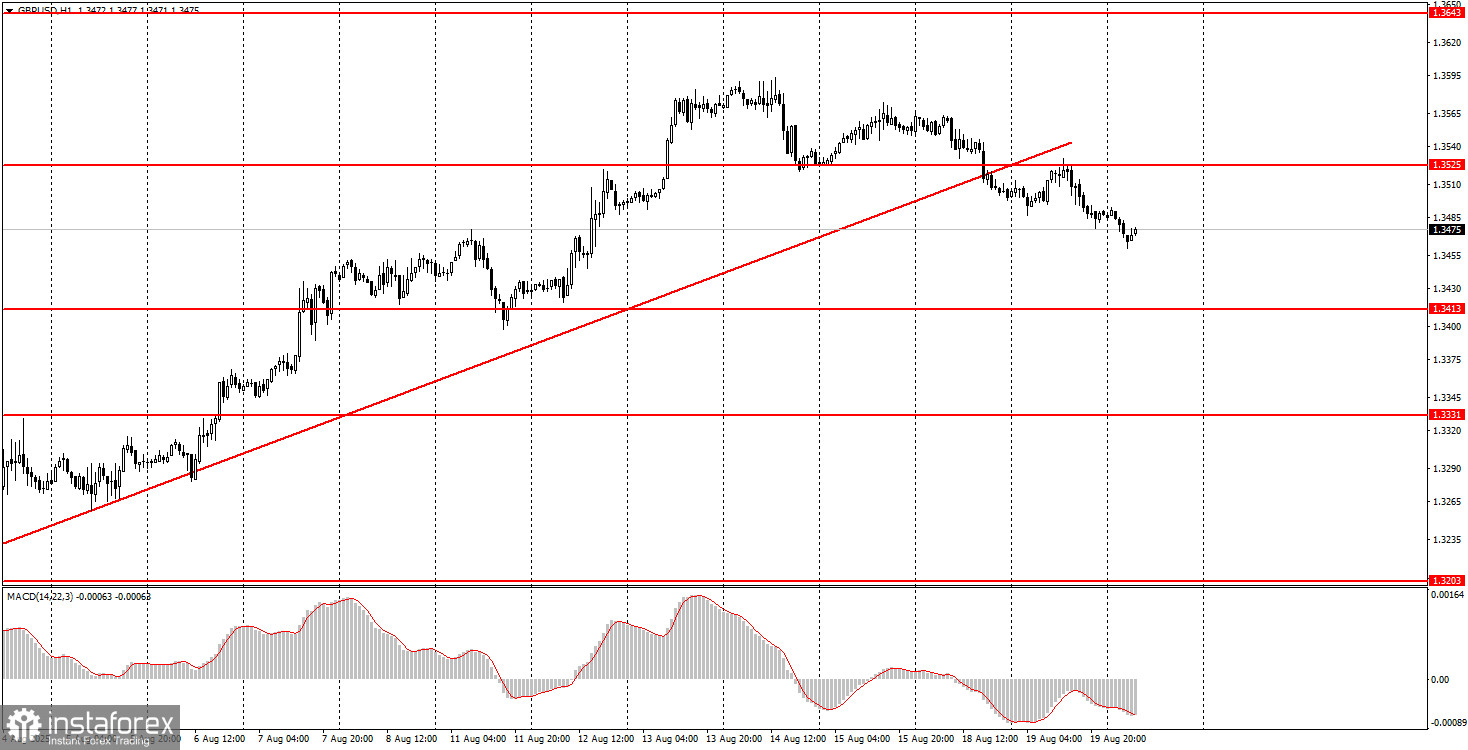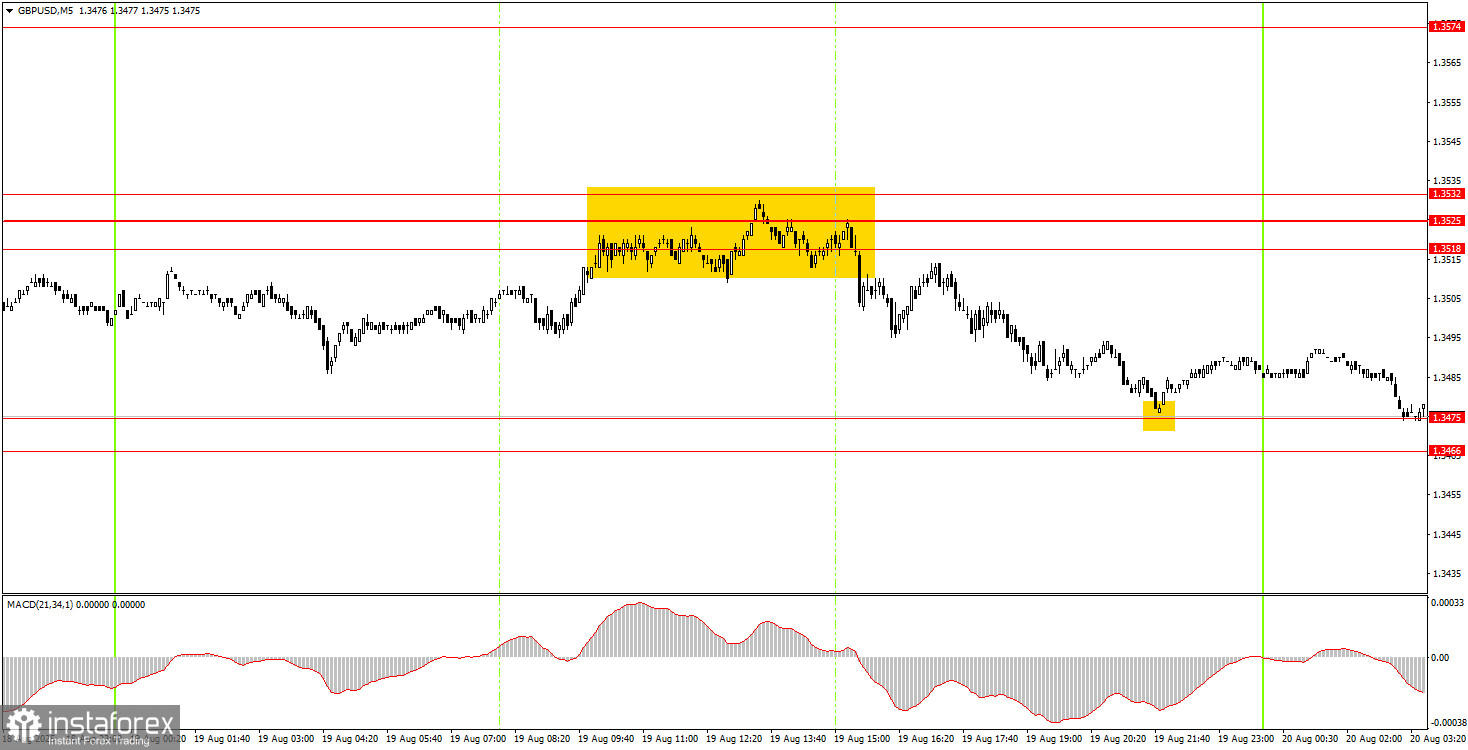Analysis of Tuesday's Trades
1H Chart of GBP/USD

On Tuesday, the GBP/USD pair traded with a slight decline, which was not triggered by any events or reports. The ascending trendline has been broken, and unlike the euro, the British pound is not standing still. A slight downward correction is underway. Since there will be virtually no news until the end of the week, a continued decline is possible. The pound had been rising against the U.S. dollar for two consecutive weeks, so a minor technical correction before a new rise would not be out of place. Jerome Powell's speech on Friday could theoretically support the dollar if the Federal Reserve Chair maintains a hawkish tone. Such a scenario cannot be ruled out entirely. At the same time, it is clear to everyone that the Fed will soon resume monetary policy easing. This easing by the U.S. central bank is a new bearish factor for the dollar.
5M Chart of GBP/USD

On the 5-minute timeframe on Tuesday, two decent trading signals were formed. In recent days, the pound has been trading more strongly than the euro. Around the 1.3518–1.3532 area, a reversal occurred, which allowed novice traders to open short positions. By the end of the day, the price dropped to the 1.3466–1.3475 area. A rebound from this area today would allow for long positions, while a breakout below it would justify shorts.
Trading Strategy for Wednesday:
On the hourly timeframe, GBP/USD shows that a new short-term downward trend could be starting. We believe this will be just another correction, as the fundamental and macroeconomic background has not recently become more favorable for the dollar. Since there will be very few macroeconomic and fundamental events this week, trading can be based on the technical picture.
On Wednesday, GBP/USD may well resume upward movement, but locally it could continue to fall if the 1.3466–1.3475 area is broken. We believe today, traders should use local technical levels on the 5-minute timeframe to open positions.
On the 5-minute timeframe, trading can currently be based on the levels 1.3102–1.3107, 1.3203–1.3211, 1.3259, 1.3329–1.3331, 1.3413–1.3421, 1.3466–1.3475, 1.3518–1.3532, 1.3574–1.3590, 1.3643–1.3652, 1.3682, 1.3763. For Wednesday, the UK is scheduled to publish its inflation report. This report, which is released in a single version, carries much greater weight than the eurozone's second inflation estimate. Therefore, volatility in the pound may increase somewhat in the coming hours.
Core Trading System Rules:
- Signal Strength: The shorter the time it takes for a signal to form (a rebound or breakout), the stronger the signal.
- False Signals: If two or more trades near a level result in false signals, subsequent signals from that level should be ignored.
- Flat Markets: In flat conditions, pairs may generate many false signals or none at all. It's better to stop trading at the first signs of a flat market.
- Trading Hours: Open trades between the start of the European session and the middle of the US session, then manually close all trades.
- MACD Signals: On the hourly timeframe, trade MACD signals only during periods of good volatility and a clear trend confirmed by trendlines or trend channels.
- Close Levels: If two levels are too close (5–20 pips apart), treat them as a support or resistance zone.
- Stop Loss: Set a Stop Loss to breakeven after the price moves 20 pips in the desired direction.
Key Chart Elements:
Support and Resistance Levels: These are target levels for opening or closing positions and can also serve as points for placing Take Profit orders.
Red Lines: Channels or trendlines indicating the current trend and the preferred direction for trading.
MACD Indicator (14,22,3): A histogram and signal line used as a supplementary source of trading signals.
Important Events and Reports: Found in the economic calendar, these can heavily influence price movements. Exercise caution or exit the market during their release to avoid sharp reversals.
Forex trading beginners should remember that not every trade will be profitable. Developing a clear strategy and practicing proper money management are essential for long-term trading success.





















